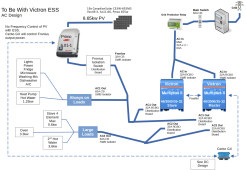Thanks to all that responded.
I have done some further digging to the regulatory framework that seems to mimic a game of 3 dimensional chess being in played 4 dimensions.
Thinking that AS/NZS 5139:2019 (Electrical installations — Safety of battery systems for use with power conversion equipment) would be the best place to start, its defines at 1.3.28 that a 'competent person' is:
person who has acquired knowledge and skill, through training, qualifications, experience, or a combination of these, and which enables that person to correctly perform the task required
and at 6.2.1 Installation Requirements - General
Battery systems and BESSs shall be installed by competent persons.
Reasonable and
Dunning-Kruger Effect notwithstanding, persons having done their research, could implement AS/NZS 5139, have a reasonable amount of electrical experience, having some humility, being cautious and being so inclined, could meet the requirements.
However, I came across this:
Australia, worst place in the world for DIY electrical which caused me question everything.
Fear, Uncertainty & Doubt (FUD) starts to gnaw away. At this point, I usually start down the research rabbit hole of Australian Law starting with my home and contents insurance policy.
Lo and behold, it contains the words:
What we don’t cover
Loss, damage, injury or death arising from:
• any illegal activity you or your family are involved in.
amongst other things.
Surely that is to exclude cover for using my house as a Meth Lab (Breaking Bad) with a consequent explosion, but I had better be sure.
I dig a bit further into the Electricity Safety Act 1998 which states at s38:
Division 2—Licensing of electrical workers
38 Electrical workers
A person must not carry out or offer to carry out or hold out that the person carries out or is willing to carry out any class of electrical work that, under the regulations, is a prescribed class of electrical work for the purposes of this Division unless the person is—
(a) licensed under this Division as an electrical installation worker in respect of electrical installation work of that class;
Penalty: 50 penalty units.
One penalty unit is currently AUD$184.92 , so a fine for this infringement is AUD$9,246. To be avoided if possible.
But there is question of does the installation of 280AH 51.2V LiFePO4 under AS/NZS 5139 constitute a '
prescribed class of electrical work'.
The Electricity Safety Act 1998 also includes the following:
45 Inspection of electrical installation work
(1) A person who is responsible for the carrying out of prescribed electrical installation work must ensure that that work is inspected by a licensed electrical inspector in accordance with the regulations before the electrical installation is connected to the electricity supply, or if the electrical circuits or electrical equipment handled in the course of the work were not disconnected from the electricity supply, before the work is first used after it is completed.
Penalty: In the case of a natural person, 40 penalty units;
Lets look at the Electricity Safety (General) Regulations 2019
battery system means a battery or battery energy storage system that has—
(a) a nominal operating voltage exceeding 12 volts direct current; and
(b) an individual or combined rated storage capacity equal to or greater than one kilowatt hour;
212 Battery systems
A battery system must be installed, altered, repaired or maintained in accordance with AS/NZS 5139.
249 Electrical installation work that must be inspected
(3) For the purposes of section 45 of the Act, prescribed electrical installation work means electrical installation work on all or part of any battery system including work on associated wiring systems, switchgear, controlgear and accessories.
Bottom line - even if I install a 280AH 51.2V LiFePO4 battery system according to AS/NZS 5139 with all of the hazards addressed,
(a) Electrical hazard.
(b) Energy hazard.
(c) Mechanical hazard.
(d) Fire hazard.
(e) Explosive gas hazard.
(f) Chemical hazard.
(g) Toxic fume hazard.
it would likely be considered an offence because I am not a licensed electrical worker, pay a large fine or fines and not have any insurance.
I can understand these rules for battery systems with high voltages (Tesla Powerwall 350-450V DC) and unsafe chemistries (NMC, etc) but !@#$%.
Next step will be to find a friendly local electrician with some knowledge of AS/NZS 5139 and ask them if they want a free Apprentice for a short period to do some specific work.

That is the only thing I can think of - sadly.






